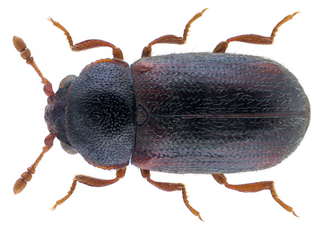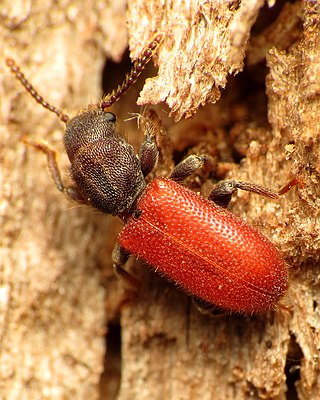
The whirligig beetles are water beetles, comprising the family Gyrinidae that usually swim on the surface of the water if undisturbed, though they swim underwater when threatened. They get their common name from their habit of swimming rapidly in circles when alarmed, and are also notable for their divided eyes which are believed to enable them to see both above and below water. The family includes some 700 extant species worldwide, in 15 genera, plus a few fossil species. Most species are very similar in general appearance, though they vary in size from perhaps 3 mm to 18 mm in length. They tend to be flattened and rounded in cross section, in plain view as seen from above, and in longitudinal section. In fact their shape is a good first approximation to an ellipsoid, with legs and other appendages fitting closely into a streamlined surface. Whirligig beetles belong to the beetle suborder Adephaga, which also includes ground beetles and diving beetles.

Histeridae is a family of beetles commonly known as clown beetles or hister beetles. This very diverse group of beetles contains 3,900 species found worldwide. They can be easily identified by their shortened elytra that leaves two of the seven tergites exposed, and their geniculate (elbowed) antennae with clubbed ends. These predatory feeders are most active at night and will fake death if they feel threatened. This family of beetles will occupy almost any kind of niche throughout the world. Hister beetles have proved useful during forensic investigations to help in time of death estimation. Also, certain species are used in the control of livestock pests that infest dung and to control houseflies. Because they are predacious and will even eat other hister beetles, they must be isolated when collected.

Blister beetles are beetles of the family Meloidae, so called for their defensive secretion of a blistering agent, cantharidin. About 7,500 species are known worldwide. Many are conspicuous and some are aposematically colored, announcing their toxicity to would-be predators.

Prostomidae is a family of beetles with no vernacular common name, though recent authors have coined the name jugular-horned beetles. They are often found in dead wood. The family consist of two extant genera with about 20 species. Prostomis americanus is known from North America. Other species of Prostomis are found in Europe, Africa, the Pacific region and East Asia. Species of Dryocora are known from New Zealand, Australia and Tasmania.

Leiodidae is a family of beetles with around 3800 described species found worldwide. Members of this family are commonly called round fungus beetles due to the globular shape of many species, although some are more elongated in shape. They are generally small or very small beetles and many species have clubbed antennae.

Syntelia is a genus of beetles. It is the only genus in the family Synteliidae. There are seven known species, which are native to high-elevation regions in southern North America from central Mexico to Guatemala, and in eastern Asia, from India to Japan and eastern Russia. They are generally associated with rotting logs, typically found under bark, though the Mexican species S. westwoodi has been found inside large decaying columnar cacti. Adults and larvae are predatory, feeding on insect larvae. A fossil species, Syntelia sunwukong, is known from the Late Cretaceous (Cenomanian) aged Burmese amber of Myanmar. Adults are around 1–3.5 centimetres (0.39–1.38 in) in length. The characteristics of the family and genus include geniculate antennae with 3-segmented club, elongate body, narrowly separated coxae and tarsi with bisetose empodia. Only one abdominal segment is exposed behind elytra. The genus described by John O. Westwood in 1864, while the family was erected by George Lewis in 1882. They are members of Histeroidea, which also includes clown beetles (Histeridae).

Lepicerus is a genus of myxophagan beetles containing three described species in the family Lepiceridae; it is the only extant genus in the family, with another genus, Lepiceratus only known from fossils. Extant species occur in the Neotropics, from Mexico south to Venezuela and Ecuador. Fossils referrable to the genus are known from the early Late Cretaceous of Southeast Asia.

Jacobsoniidae are a family of tiny beetles belonging to Staphylinoidea. The larvae and adults live under bark, in plant litter, fungi, bat guano and rotten wood. There are around 28 described species in three genera:

Trogossitidae, also known as bark-gnawing beetles, are a small family in the superfamily Cleroidea. Many taxa formerly within this family have been removed to other families, such as Lophocateridae, Peltidae, Protopeltidae, Rentoniidae, and Thymalidae. Members of the family are generally predatory and/or feed on fungi, both in adult and larval stages, and are generally associated with wood, being found under bark or inside bored tunnel galleries. There are about 400 species in 25 genera in the family under the new, restricted circumscription, as opposed to 600 species in over 50 genera in the old definition. The oldest fossil assignable to the modern, more restricted definition of the family is Microtrogossita from the mid-Cretaceous Burmese amber of Myanmar, which has close affinities to the Trogossitini, indicating that the family had already considerably diversified by this time.

Kateretidae also known as short-winged flower beetles are a family of beetles in the superfamily Cucujoidea. There are 10 extant and 4 extinct genera, and at least 40 described species. They are found worldwide except in New Zealand. Adults are anthophagous, feeding on flowers, while the larvae are spermatophagous inside the flower corolla.

Sphindidae is a family of beetles, in the suborder Polyphaga. They are called slime mold beetles due to their exclusive feeding on slime molds during adult and larval stages, other aspects of their life history are obscure. Palaeontological discoveries since 2015 have added to the geologic history of Sphindidae, including the discovery of Libanopsis, placed in the extinct subfamily Libanopsinae.

Smicripidae is a family of beetles, in the superfamily Cucujoidea. The common name for this family is palmetto beetles. The family only has one extant genus, Smicrips, with six extant species native to tropical and subtropical regions of the Americas and extinct species from the Eocene of Europe and one extinct genus, Mesosmicrips, known from the mid Cretaceous aged Burmese amber. Smicrips larvae are usually found amongst decaying vegetation, while adults are typically found on inflorescences, especially those of Arecaceae (palms), although associations with flowers of Fabaceae (legumes), Passifloraceae, Bombacaceae and Cactaceae (cactus) have also been recorded. Their diet is unknown.

The Brachypsectridae are a family of beetles commonly known as the Texas beetles. There are only two extant genera, Brachypsectra and Asiopsectra. Brachypsectra has a cosmopolitan distribution, mostly in arid regions, while Asiopsectra is found in Central Asia and the Middle East.

Scirtidae is a family of beetles (Coleoptera). These beetles are commonly referred to as marsh beetles, as the larvae are typically associated with stagnant water, but can be found in flowing water. Adults prefer decomposing plant material near the water's edge. More than an estimated 600 species are known worldwide, distributed among at least 60 genera.

Gyrininae is a subfamily of ground and water beetles in the family Gyrinidae. There are at least 740 described extant species in Gyrininae.

Anamorphidae is a family of beetles in the superfamily Coccinelloidea, formerly included within the family Endomychidae. They are found worldwide. Like enchomyids, they are fungivores, with adult and larval stages thought to exclusively consume fungal spores.

Throscidae is a family of elateroid beetles found worldwide with around 150 species in 5 extant genera. The larvae are soil-dwelling, siphoning fluid from mycorrhizae attached to trees. The adults are short-lived, with the adult males being noted for a complex mating dance. Like some other elateroids, they are capable of clicking.

Thanerocleridae is a family of beetles belonging to the superfamily Cleroidea. It was formerly considered a subfamily of Cleridae, but was recently elevated to the rank of family. The family has 36 living species in 10 genera, which are found globally, mostly in low-latitude tropical regions, though the genus Zenodosus is found in temperate North America. Thaneroclerid species are likely all predatory both in adult and larval stages. They target small fungus and wood associated beetles, and are generally found in places where such beetles are likely to be found, typically tree associated habitats such as under bark, though some species occur in other locations such as termite nests.
Hydrovatus castaneus, is a species of predaceous diving beetle found in India, Myanmar, Indonesia, Sri Lanka, Bangladesh, and China.

Cybister tripunctatus, is a species of predaceous diving beetle found in India, Andaman & Nicobar Islands, Sri Lanka, Afghanistan, Bangladesh, Myanmar, Nepal, Pakistan, Bhutan, China, Cyprus, Iran, Iraq, Japan, Kyrgyzstan, Mongolia, Russia, Syria, Tajikistan, Turkmenistan, Italy, Turkey, Uzbekistan and Europe.


















